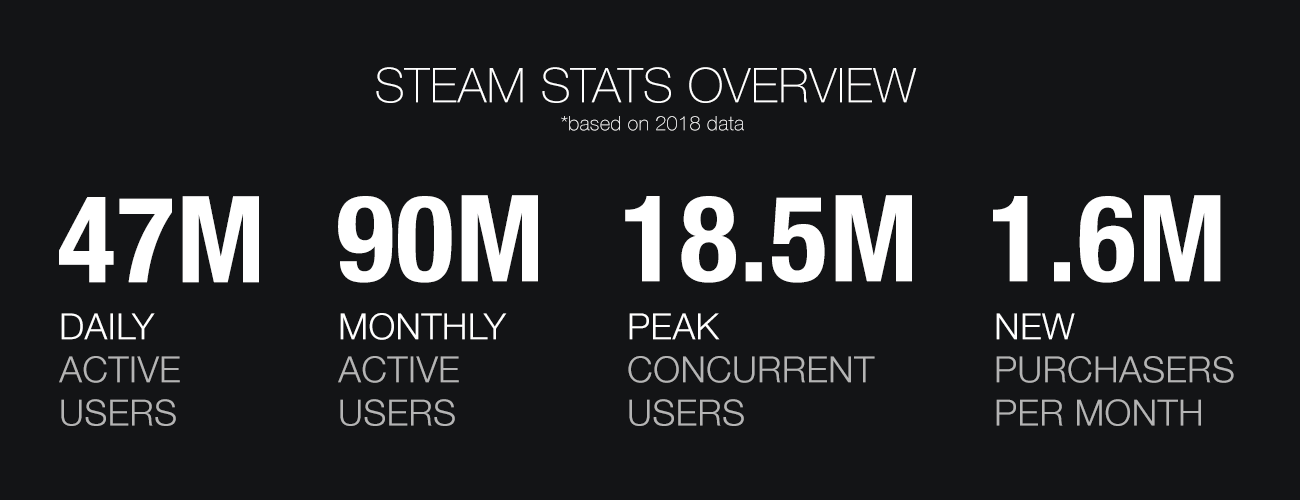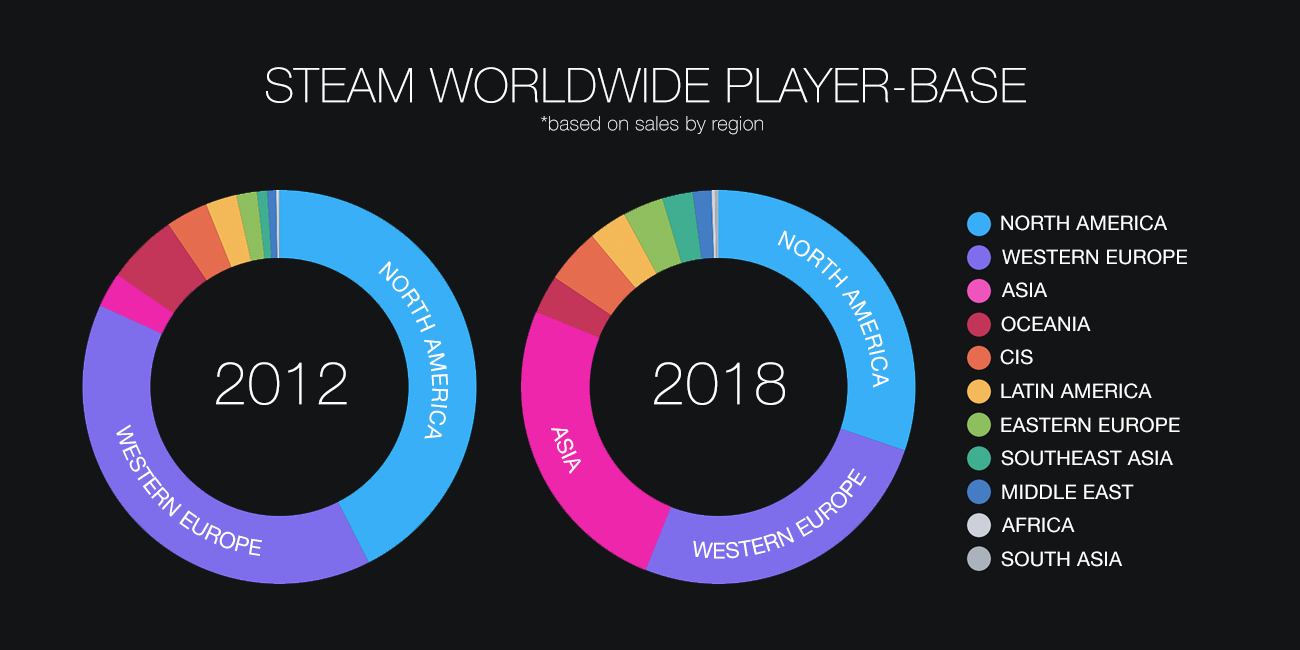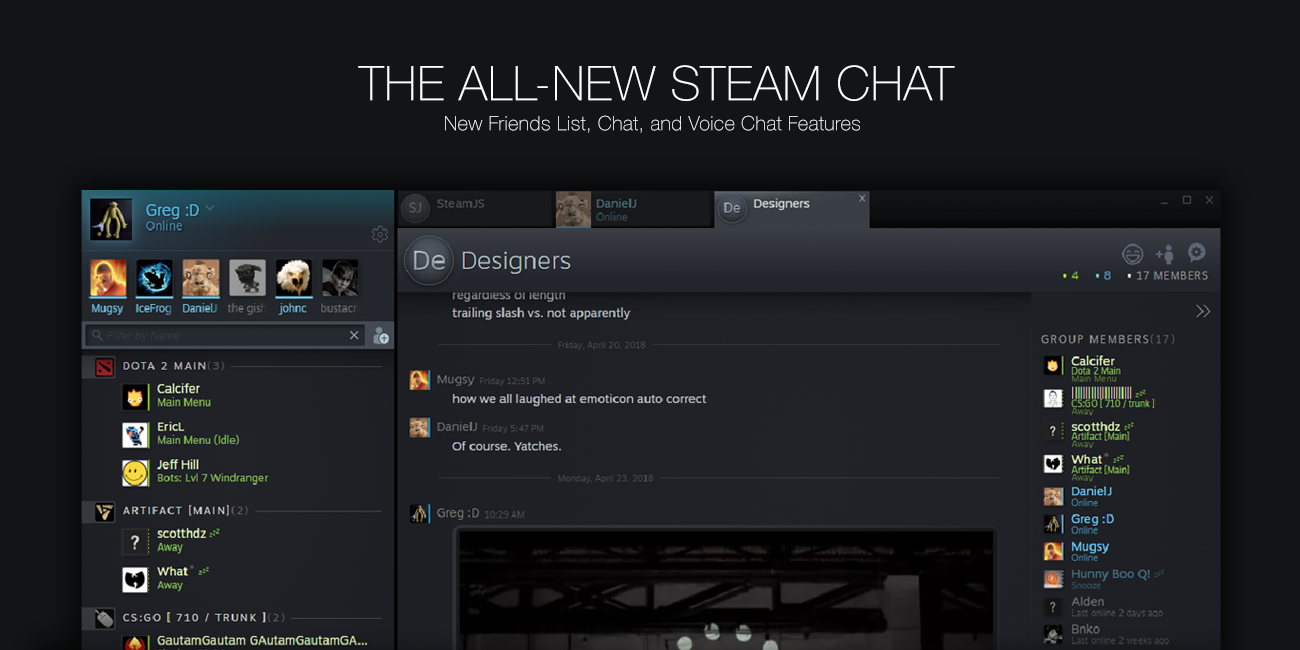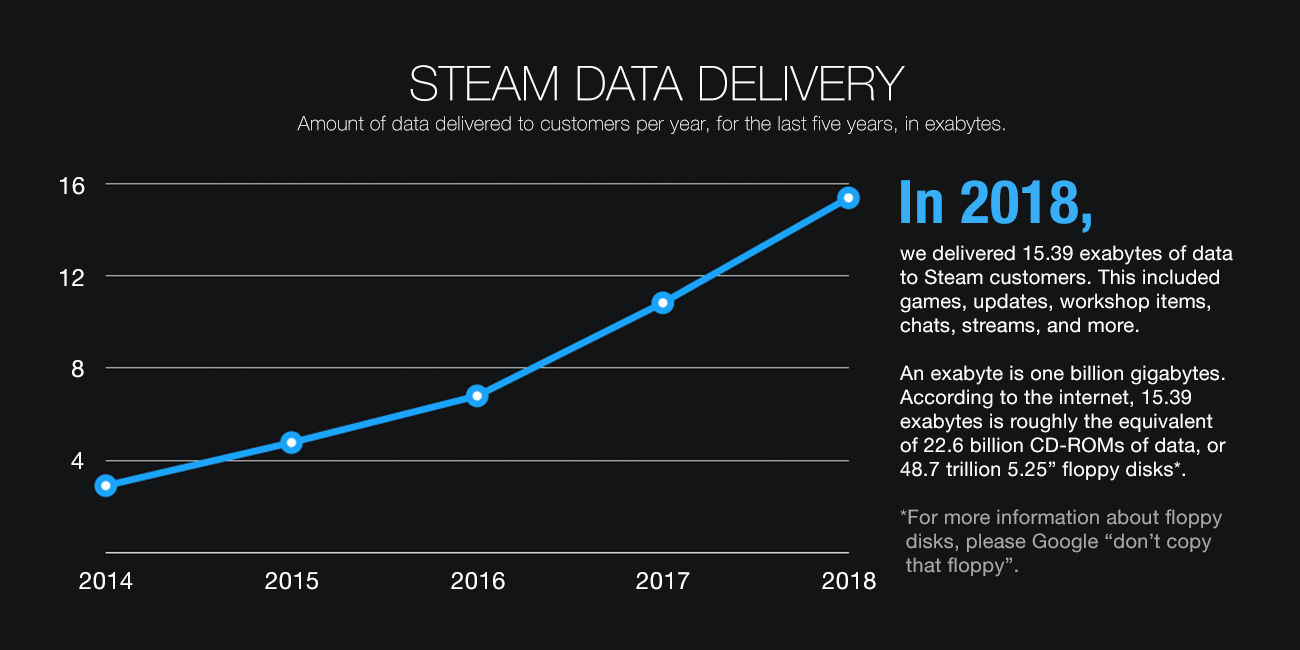Steam Community :: Group :: Steamworks Development
At the end of each year, we like to take time to assess the work we've done over the past twelve months and do some planning for the future. This is an informal, internal process and normally isn't the type of thing we'd publicize. But as we started to look at the work we put into Steam in 2018, we realized that not all of it is visible to our partners. So this year, we thought it might be interesting to share some of this information with you.

The Store
You may not remember this (or maybe you do), but the first couple of years for Steam were pretty rocky. We didn't have much beyond a rudimentary client, a way for users to buy games, and servers to deliver those bits (most of the time). Fast-forward to 2018 and the challenges we faced this year alone were far beyond what we could've imagined back when we first launched the Store. We had to deal with the reality of what it means to have the open platform that we've committed to building. Ninety million different people visiting Steam each month means the Store needs to be dynamic enough to cater to a diverse set of interests, and give games from developers big and small a chance to find their audience.
So we made the Upcoming Games List more useful, expanded our content filtering tools to support adult-only content (and make sure only people who wanted to see it would see it), put in place restrictions to deal with fake games, and removed (and continue to remove) troll developers. We worked on the feature set for Steam Curators, giving users alternate views of the store presented by voices they trust. We added Developer & Publisher home pages so you can have a space on Steam where customers can browse your titles and be notified when you ship new games. And to help make sense of the inner workings of the Store, we upgraded the tools that let you analyze the navigation traffic for your games.
In addition to dealing with the increase in content, we worked on changes to the Wishlist, and made game pages more rich by allowing you to embed Steam Broadcast streams or animated GIFs (officially!).
Beyond the more visible new features and improvements, we made Steam more accessible to players around the world. We (finally) added the Australian Dollar to the set of 40 currencies. We continued to monitor currency fluctuations, like in the case of the Turkish Lira, and updated our suggested regional pricing when appropriate to keep games affordable in those regions. We added dozens of payment providers, bringing the total supported to over 100 (even one called HappyMoney in South Korea). We also launched Steam wallet cards in Japan and Poland, which means we now accept cash payment in 45 countries. And we added Vietnamese & Latin American Spanish to the list of now 26 languages the Steam Client supports.

The Steam Community
The biggest set of Steam Community features we shipped in 2018 revolved around the revamp of Steam Chat, which aimed to give users the things they expected in a modern chat program. There are many features that shipped in the update, but some of the more noteworthy pieces were a vastly improved group chat, a more flexible Friends List, deeper and more detailed Rich Presence, and a completely rewritten voice chat system that utilizes WebRTC over our private network (resulting in a higher quality, more secure voice chat experience). We then combined a lot of this Steam Chat tech with Steam Broadcast to ship an early version of Steam TV that we tested out with The International and with Artifact at PAX.

As with any significant online gathering place, discussions in the Steam Community sometimes escalate into toxic disagreements. It can be difficult to find a balance between letting players talk to each other freely and making sure that discussions don't degenerate and spin out of control. So we built more moderation tools and assembled a full-time moderation team to help ensure that your game forums remain healthy, to manage reports of harassment, and to deal with reported user generated content. Since we started moderating game forums in late September, our team has gone through 113,290 reported posts, most of which were resolved in less than a day. The team also looked at 332,768 reports on user generated content across all game community hubs (300 million pieces of content were posted last year).
And because the community around a game can be quite large, sometimes there's content that's inappropriate for a wider audience. Let's say someone installs a mod for your game that "reimagines" your characters in explicit ways that die-hard fans may not consider "canon" or "safe for work." Some customers may very well not want to see a screenshot of that on your game's community page, but other people might be fine with it. So we leveraged Google's Vision API and Amazon Rekognition (yes, it's really spelled that way) to identify inappropriate images and blur them by default (which is a feature that can always be turned off by customers).
Other features we worked on include giving users more control over their privacy settings, complying with GDPR, and making it easier to add friends. And we also had some community building events, like the Spring Cleaning Event, the Salien Game during the Summer Sale, the Extremely Cozy Cottage for the Winter Sale, and the annual Steam Awards.
More Ways to Play
In August we shipped a new version of Steam Play, the feature that allows customers to buy a game once and then play it on any supported OS. With the latest update, Linux users can now play many Steam games that previously only ran on Windows, with no additional development work required by developers. We initially launched a beta with support for two dozen titles, but the community quickly took on the task of testing out which games worked, reporting that over 3,400 games were compatible (we're a bit more cautious about adding games to the official white-list, since even small differences will fail our compatibility tests). We still want to make it easy for you to support customers on whatever platform they prefer to play on, which is why we continued to invest in Vulkan and built things like Shader Pre-caching to support it.
Using a controller versus a keyboard & mouse is an increasingly popular way to play games. At last count, 36.7 million players have used a controller to play a game on Steam. This is a big reason why we've continued to work on Steam Input, which now supports more than 300 devices, including the Nintendo Switch Pro (and dancepads!). If you've integrated with Steam Input, your game will support all these devices without any additional work.

In 2018 we continued to improve and evolve the experience in high-end PC VR in a variety of ways. We introduced SteamVR Input to provide an input abstraction layer for developers, so you won't have to worry about all the different kinds of controllers SteamVR supports (we also updated the SteamVR Unity Plugin to support SteamVR Input). We then released SteamVR Skeletal Input, which allows VR controllers to capture the pose of the user’s hands as accurately as their sensors are able, and provide it to VR applications as a stream of animation data that developers can use to animate the hands of the user’s avatar and drive hand-based interactions with the VR world. And in November, we shipped SteamVR Motion Smoothing, which enables more players on more PCs to play high-fidelity VR games and experiences. When SteamVR sees that an application isn’t going to make framerate (i.e. starts dropping frames), Motion Smoothing kicks in--it looks at the last two delivered frames, estimates motion and animation, and extrapolates a new frame.
SteamVR Home also got a number of upgrades, including the ability to spawn new Steam panels and the ability for content creators to use assets packs when building their environments (hooray for content reuse!). And we released a bunch of content for SteamVR Home as well, including collectibles for games like Moss and Skyrim VR, and environments such as the Team Fortress 2 Supervillain Lair, The Candy Emporium and Winter Peak.
We also updated the Steam Link app to support Android and Raspberry Pi, so customers can stream & play your games on their big-screen TV or their tiny phone.
More Steamworks Features
In 2018 the Steam Inventory Service, the tech that powers the persistent items for games like PUBG, got an upgrade, making it possible for any Steam game to have items with unique, dynamic properties. What that means is that you can implement things like flaming purple hats that keep track of headshots with some simple configuration scripts and we handle all the rest. As a side note, 3.8 billion items were created across all Steam Inventory Service Games last year (surprisingly, not all of them were hats).
We also took what we learned about mitigating denial-of-service attacks on our own games and made it available to some non-Valve multiplayer titles in a private beta. And since you ship your games on multiple platforms, we made the GameNetworkingSockets[github.com] library open source and Steam agnostic. The Steam version of your game can take advantage of our private network and get the same DoS protection that Dota 2 or CS:GO have. This means that we'll relay all your game network traffic, which keeps the IP addresses of your game servers and clients anonymized, and safe from the script kiddies. In the coming year we're planning to let you use our private network for the non-Steam version of your game as well.
Behind the Scenes
Lots of infrastructure work was done in 2018. For instance, we performed a significant upgrade to the Solr servers that power Store search, User Reviews, and the Steam Workshop. We continued to work on our disaster recovery plan so Steam doesn't go under if our main data center is hit by a meteorite. We deployed new SQL Servers, now with 2.7 petabytes of FAST solid state storage, to keep up with the 1.7 billion trading cards granted, the 488 million trades completed, the 245 million emoticons crafted, and the 218 million screenshots posted in the last year.
Since 2015, we have been building and operating our own global private network. We partner with Internet backbone companies around the world to build this network, which connects directly with over 28,000 regional and local networks in 28 cities in 21 different countries. This private network lets us deliver games and carry game, voice chat, and other data with high speeds and low latency to users in more than 229 countries. Our edge network capacity is now 12 Tbps, and is growing 50% year over year. We delivered over 15 exabytes (15 billion gigabytes) of data to customers in 2018. For reference, the entire traffic of the Internet in 2003 (the year we launched Steam) is estimated at 9.3 exabytes.

We improved security across the Steam websites by moving them entirely to HTTPS-only. We also launched a bug bounty program with Hackerone[hackerone.com] in May, to help mitigate and quickly address security related issues. To date, we've paid out over $471,000 to security researchers that help us keep our platform safe and secure.
In May 2017 we talked about the state of Steam Support and our efforts to improve it. At that time we made public some help request stats to hold ourselves accountable for creating a better customer support experience. In 2018 Steam Support processed over 44 million help tickets submitted by both customers and game developers. And it's not just help tickets–in 2018 our game review team processed 46,200 review requests, played 11,111 games (or DLC), and examined 17,448 store pages.
We paid nearly 10,000 partners in the last twelve months, of which 2,300 were new to our platform. We also changed the Steamworks Distribution Agreement to reward titles that hit certain revenue levels on Steam, and also to make it clear that you can share your game sales data as you see fit.
We also paid 1,668 Workshop Contributors for the ~4,700 new items that shipped in 16 different games in 2018. The Steam Workshop is now used in almost 1,000 games, with almost 3.2 million items uploaded in just the last year.
And we've racked up the frequent flier miles, traveling to over 35 cities around the globe: from Level Up![levelupkl.com] in Kuala Lumpur, Malaysia to Indigo[www.dutchgamegarden.nl] held by Dutch Game Garden in Utrecht, Netherlands, we've met with thousands of partners at events and conferences to answer questions and solicit feedback on the Steam platform.
2019 and Beyond
Doing this sort of retrospective is useful to us as a team, because it helps us better understand what we've done and where we should go from here. While we feel like we've accomplished a lot in 2018, there's still a ton more work to do, features to build, and hard problems to solve. Here's a sneak peek at a few of the more notable things we plan to ship this year:
- Store Discoverability: We’re working on a new recommendation engine powered by machine-learning, that can match players to games based on their individual tastes. Algorithms are only a part of our discoverability solution, however, so we're building more broadcasting and curating features and are constantly assessing the overall design of the store.
- Steam China: We've partnered with Perfect World to bring Steam onshore into China. We'll reveal more details about this in the coming months.
- Steam Library Update: Some long awaited changes to the Steam Client will ship, including a reworked Steam Library, built on top of the technology we shipped in Steam Chat.
- New Events System: We're upgrading the events system in the Steam Community, enabling you to highlight interesting activities in your games like tournaments, streams, or weekly challenges.
- Steam TV: We're working on expanding Steam TV beyond just broadcasting specific tournaments and special events, in order to support all games.
- Steam Chat: We're going to ship a new Steam Chat mobile app, so you can share your favorite GIFs with your friends while on the go.
- Steam Trust: The technology behind Trusted Matchmaking on CS:GO is getting an upgrade and will become a full Steam feature that will be available to all games. This means you'll have more information that you can use to help determine how likely a player is a cheater or not.
- Steam PC Cafe Program: We are going to officially ship a new PC Cafe Program so that players can have a good experience using Steam in hundreds of thousands of PC Cafes Worldwide.
There's certainly no shortage of opportunities, and we could always use more people who can help make Steam a better place for both developers and customers. If you are interested in tackling hard problems and are up for the challenge, you can apply for a job on our new company website, which we also relaunched this past year.




 )
)
